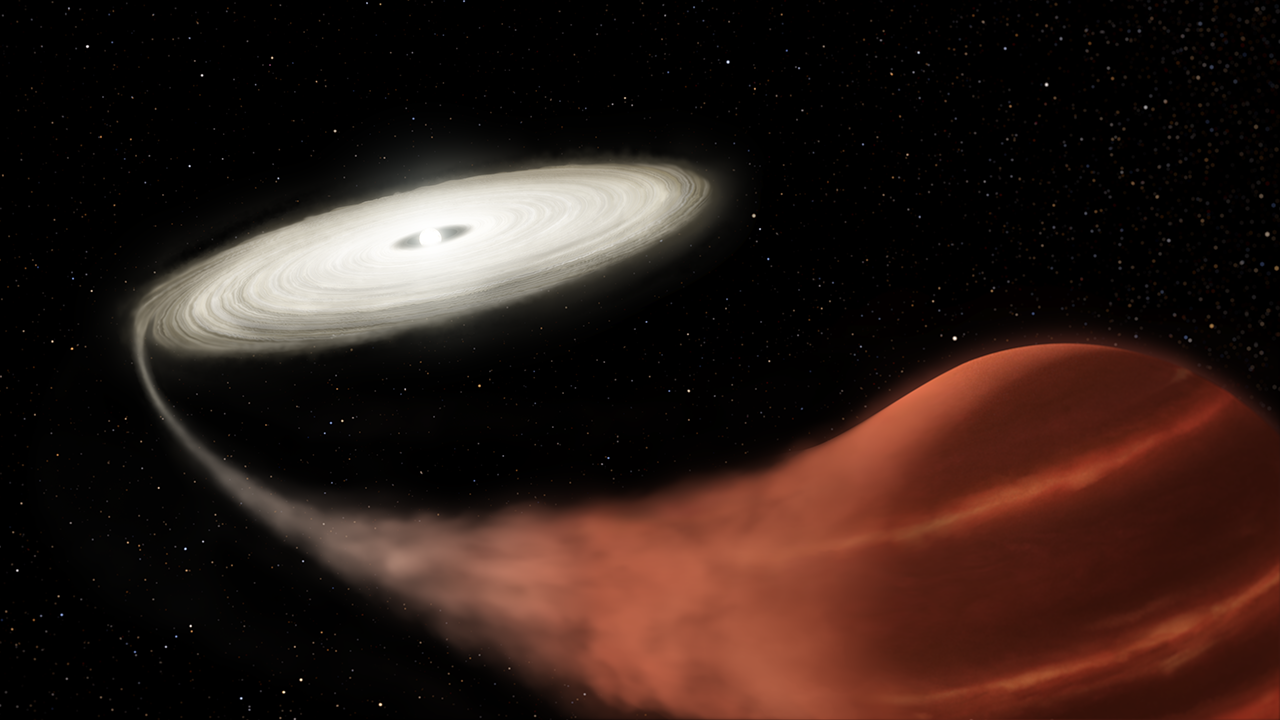'Vampire' star sparks brilliant 'super-outburst' while gorging on its neighbor
An undead vampire star feeds on its victim, the two tug hard on this lifeblood swirling in space — then boom, and repeat.

A "vampire" dwarf star is sucking the life force from its partner star, and their entanglement produced a rare superoutburst.
NASA detailed this previously unknown dwarf nova, a brief eruption from dwarf stars, in a statement on Jan. 24. The system brightened by a factor of 1,600 over less than a day, space agency officials said in the statement, and this uncommon sighting was made by a mission targeting an entirely different cosmic population.
This rare finding was made by "accident," according to the research team that found the super-outburst. The Kepler Space Telescope is now retired, but when it was scouring the sky, it searched for exoplanets that dimmed their parent stars as they moved across those stellar faces. Because it was designed to look for variations in brightness, Kepler was able to pick up on this super-outburst.
Related: 7 Greatest Alien Planet Discoveries by NASA's Kepler Spacecraft
"In a sense, we discovered this system accidentally," Ryan Ridden-Harper, a researcher from the Space Telescope Science Institute (STScI) in Baltimore, who led the team that found the dwarf outburst, said in the statement.
"We weren't specifically looking for a super-outburst. We were looking for any sort of transient," he added. The team members were looking through archived Kepler data when they made their finding.
Only about 100 dwarf nova systems have ever been spotted, and the brightness spike of the recent finding lasted just a day. So, even if scientists are lucky enough to find this kind of cosmic needle in a haystack, they'd have to wait years or decades before a new outburst appears in the same system, according to NASA.
Get the Space.com Newsletter
Breaking space news, the latest updates on rocket launches, skywatching events and more!
The "vampire" in this celestial pairing is a white dwarf star, or a compact stellar corpse. Its victim is a cooler brown dwarf star that orbits the white dwarf every 83 minutes at roughly the distance between Earth and the moon. With only 250,000 miles (400,000 kilometers) between them, the gravity of the white dwarf pulls material away from the brown dwarf, forming spirals of dust and gas known as an accretion disk as it syphons in the material.
This accretion disk, according to NASA, theoretically reaches a tipping point. The disk grows until the outer edge interacts with the gravity of the gouged-out brown dwarf. This heats up the material, causing the temperature to spike dramatically as it rises from about 5,000 to 10,000 degrees Fahrenheit (2,700 to 5,300 degrees Celsius) in its "normal state" to a high of around 17,000 to 21,000 F (9,700 to 11,700 C) "at the peak of the super-outburst," NASA explained.
So, the undead vampire star feeds on its victim, the two each tug hard on this stellar lifeblood swirling in space — then boom, and repeat. The universe is always packed with surprises.
A paper describing the findings was published in the October 2019 issue of the journal Monthly Notices of the Royal Astronomical Society.
- Incredibly Powerful White-Light Superflare Erupted from a Small, Faint Star
- RIP, Kepler: NASA's Revolutionary Planet-Hunting Telescope Runs Out of Fuel
- Exoplanet Symphony: Listen to TRAPPIST-1 Worlds' Orbital Music
Follow Doris Elin Urrutia on Twitter @salazar_elin. Follow us on Twitter @Spacedotcom and on Facebook.
Join our Space Forums to keep talking space on the latest missions, night sky and more! And if you have a news tip, correction or comment, let us know at: community@space.com.

Doris is a science journalist and Space.com contributor. She received a B.A. in Sociology and Communications at Fordham University in New York City. Her first work was published in collaboration with London Mining Network, where her love of science writing was born. Her passion for astronomy started as a kid when she helped her sister build a model solar system in the Bronx. She got her first shot at astronomy writing as a Space.com editorial intern and continues to write about all things cosmic for the website. Doris has also written about microscopic plant life for Scientific American’s website and about whale calls for their print magazine. She has also written about ancient humans for Inverse, with stories ranging from how to recreate Pompeii’s cuisine to how to map the Polynesian expansion through genomics. She currently shares her home with two rabbits. Follow her on twitter at @salazar_elin.









